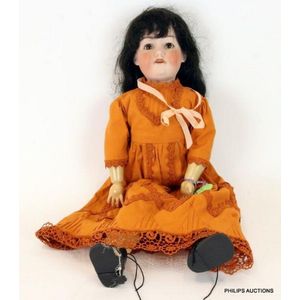A German Armand Marseille doll, circa 1915, the 390 mould doll…
A German Armand Marseille doll, circa 1915, the 390 mould doll with markings A5M and 390, with a bisque socket head, brown glass dormant eyes, painted lashes and brows, with an open mouth, and upper teeth, the composite body with jointed limbs, with an orange embroidered Indian style dress, over hose and small black shoes. Length 55 cm
You must be a subscriber, and be logged in to view price and dealer details.
Subscribe Now to view actual auction price for this item
When you subscribe, you have the option of setting the currency in which to display prices to $Au, $US, $NZ or Stg.
This item has been sold, and the description, image and price are for reference purposes only.
- Open Mouth Doll - An "open mouth" doll is a doll with a mouth that is designed to be open showing moulded or inserted teeth, as if the doll is in the process of speaking or singing. This type of doll was first introduced in the late 19th century and became increasingly popular in the early 20th century. Open mouth dolls were typically made of bisque, a type of unglazed porcelain that is fired at a lower temperature than traditional porcelain. The open mouth design allowed doll manufacturers to create dolls with a more expressive, lifelike appearance, as the open mouth made it possible to add teeth, a tongue, and other features that added to the doll's realism. Open mouth dolls were often dressed in elaborate costumes and accessories, and were marketed to both children and adults as decorative objects.
- Circa - A Latin term meaning 'about', often used in the antique trade to give an approximate date for the piece, usually considered to be five years on either side of the circa year. Thus, circa 1900 means the piece was made about 1900, probably between 1895 and 1905. The expression is sometimes abbreviated to c.1900.
This item has been included into following indexes:
